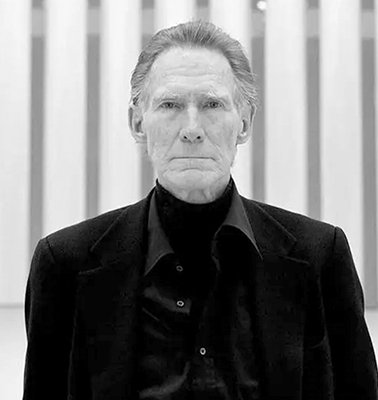JOHN MCCRACKEN (1934-2011)
 John McCracken was born December 9, 1934, in Berkeley, California, and grew up in the northern part of the state. He studied at the California College of Arts and Crafts, Oakland (1957–62), after a four-year stint in the U.S. Navy. Studying with painter Gordon Onslow-Ford and sculptor Tony DeLap, he began working in an Abstract Expressionist mode but quickly moved toward Pop-like abstract painting that incorporated emblems and corporate logos and shifted from flat canvases into sculptural reliefs. His early sculptures were basic architectural forms made of wood and painted in solid colors, such as Blue Post and Lintel (1965). By 1966, he had started to develop his signature form, the plank: a tall, narrow, monochromatic rectangle, which leaned against the wall and rested on the floor, occupying both the site of painting and the three-dimensional space of sculpture.
John McCracken was born December 9, 1934, in Berkeley, California, and grew up in the northern part of the state. He studied at the California College of Arts and Crafts, Oakland (1957–62), after a four-year stint in the U.S. Navy. Studying with painter Gordon Onslow-Ford and sculptor Tony DeLap, he began working in an Abstract Expressionist mode but quickly moved toward Pop-like abstract painting that incorporated emblems and corporate logos and shifted from flat canvases into sculptural reliefs. His early sculptures were basic architectural forms made of wood and painted in solid colors, such as Blue Post and Lintel (1965). By 1966, he had started to develop his signature form, the plank: a tall, narrow, monochromatic rectangle, which leaned against the wall and rested on the floor, occupying both the site of painting and the three-dimensional space of sculpture.
Sculpturally, his planks referenced the Minimalist work of Carl Andre, Dan Flavin, and Donald Judd. Chromatically, they reflected his interest in Barnett Newman’s color fields, although McCracken rarely varied from a specific palette of monochromes with either a glossy black or a luminous shade of yellow, pink, blue, or green (as in Black Plank or Yellow Plank, both 1965). Like others in California’s Light and Space movement, including Larry Bell and James Turrell, McCracken began exploring industrial techniques and materials such as lacquer and resin, which were ubiquitous in the surfboard production that surrounded him in Southern California, where he had moved in 1965 for a teaching post at the University of California, Irvine. Through applying resin painstakingly by hand, then burnishing the surfaces with power tools, he created the highly polished, reflective finish characteristic of his mid-career and late sculpture.
McCracken occasionally returned to painting: in the 1970s, he created a series of small, two-dimensional works based on Buddhist mandalas. He also made freestanding sculptures in the shape of pyramids, cubes, or polyhedrons, including Squidds and Nunns (1998), a black sculpture with a number of curved and angled surfaces that resembles a crystal. Between 2010 and 2011, he crafted a series of sculptures so highly polished and reflective that they seemed to be camouflaged within the space of the gallery. However, the plank, a material synthesis of what he claimed were his strongest influences, constituted the bulk of his work. While his interest in the interstices between painting and sculpture coincided with that of many other artists in the 1960s, his belief in their connection to the supernatural did not. An avid believer in extraterrestrials and time travel, he saw his works as both an approximation of the possible artistic production of an alien race and a metaphor for a connection between two worlds. The floor represented the physical world of bodies and objects, and the wall, the space of illusion and imagination.
McCracken’s first solo exhibition was held at Nicholas Wilder Gallery, Los Angeles (1965). Since then, he has had solo exhibitions at venues that include Robert Elkon Gallery, New York (1966); David Zwirner, New York (1997, 2004, 2006, 2008, 2010); Hauser and Wirth, Zurich (1999, 2005); Zwirner and Wirth, New York (2000, 2005); Stedelijk Museum voor Actuele Kunst, Ghent, Belgium (2004); Inverleith House, Royal Botanic Garden Edinburgh, Scotland (2009); and a major retrospective at Castello di Rivoli–Museo d’arte contemporanea, Italy (2011). His work has also been included in formative, historic exhibitions of Minimalism, such as Primary Structures, Jewish Museum, New York (1966), and American Sculpture of the Sixties, Los Angeles County Museum of Art (1967) as well as at Documenta, Kassel, Germany (2007). McCracken lived in Santa Fe from 1994 to his death on April 8, 2011, in New York.
(Guggenheim)
